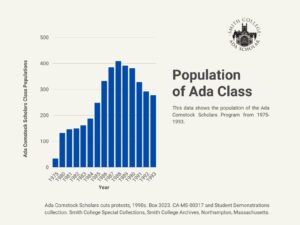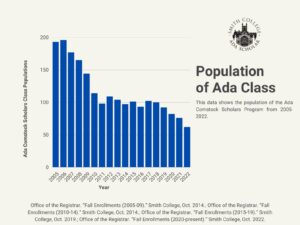Financial Aid Cuts
Under the presidency of Mary Maples Dunn, many cuts were made to the Ada Comstock Scholars Program, one among them being financial aid. Dunn explains in many correspondences, the reason for this was that traditional students needed more financial aid. It was decided by Dunn and the Advisory Committee on Resource Allocation (ACRA) that these funds be taken from the ACSP and into the traditional undergraduate allocations.1 Dunn goes on to explain that Adas make an “especially heavy demand” on financial aid with 80% of the class needing some sort of financial help; while 50% of traditional students are on aid. The average Ada grant was $3,000 higher than that of a traditional student’s. 2
However, many students protested against this view, saying that Adas have less opportunities to be financially supported by parents and other family members as they were older, and often had to still work, and potentially support one or more children. The Ada Cabinet also argued that financial aid should not be viewed in an evenly distributed way as it is not evenly distributed among the student population, and thus, can foster feelings of resentment.3
Program Size
Footnotes
- Ada Comstock Scholars cuts protests, 1990s. Box 3023. CA-MS-00317 and Student Demonstrations collection. Smith College Archives, Smith College Special Collections, Northampton, Massachusetts. ↩
- Ada Comstock Scholars cuts protests, 1990s. Box 3023. CA-MS-00317 and Student Demonstrations collection. Smith College Archives, Smith College Special Collections, Northampton, Massachusetts. ↩
- Ada Comstock Scholars, Jan-May, 1994. Box 107, Folder 8. CA-MS-0003 and Office of the President Mary Maples Dunn Files. Smith College Archives. Smith College Special Collections, Northampton, Massachusetts. ↩


